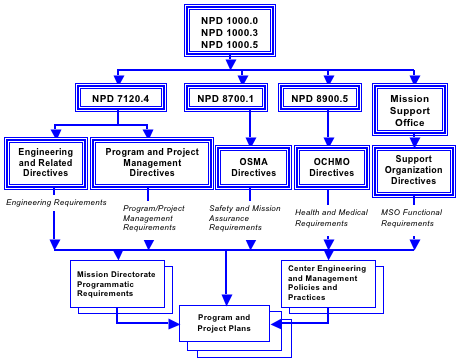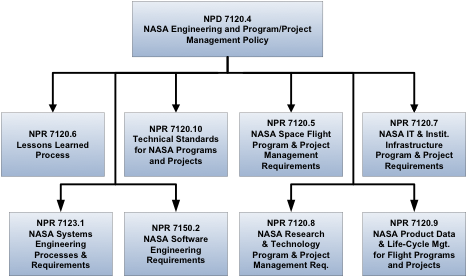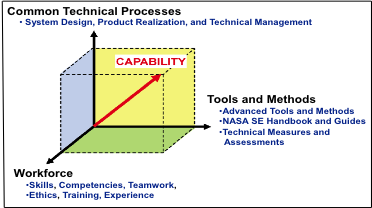Chapter 1. Introduction
1.1 Background
1.1.1 Systems engineering at NASA requires the application of a systematic, disciplined engineering approach that is quantifiable, recursive, iterative, and repeatable for the development, operation, maintenance, and disposal of systems integrated into a whole throughout the life cycle of a project or program. The emphasis of systems engineering is on safely achieving stakeholder functional, physical, and operational performance requirements in the intended use environments over the system's planned life within cost and schedule constraints.
1.1.2 This document establishes the common technical processes for implementing NASA products and systems, as directed by NPD 7120.4, NASA Engineering and Program/Project Management Policy. Additionally, this NPR establishes the common NASA systems engineering technical model. This document complements the administration, management, and review of all programs and projects, as specified in NPR 7120.5, NASA Space Flight Program and Project Management Requirements, NPR 7120.7, NASA Information Technology and Institutional Infrastructure Program and Project Management Requirements, and NPR 7120.8, NASA Research and Technology Program and Project Management Requirements.
1.1.3 The processes described in this document build upon and apply best practices and lessons learned from NASA, other governmental agencies, and industry to clearly delineate a successful model to complete comprehensive technical work, reduce program and technical risk, and improve mission success. The requirements and practices established in this NPR should be tailored and customized, respectively, per Paragraph 2.2.
1.1.4 Precedence
The order of precedence in case of conflict between requirements is 51 USC 20113(a) (1), National Aeronautics and Space Act of 1958, as amended; NPD 1000.0, NASA Governance and Strategic Management Handbook; NPD 1000.3, The NASA Organization; NPD 7120.4, NASA Engineering and Program/Project Management Policy; and NPR 7123.1, NASA Systems Engineering Processes and Requirements.
1.1.5 Figures
1.1.5.1 Figures within this NPR are not intended to be prescriptive but notional.
1.2 Framework for Systems Engineering Procedural Requirements
1.2.1 Institutional requirements are the responsibility of the institutional authorities. They focus on how NASA does business and are independent of any particular program or project. These requirements are issued by NASA Headquarters and by Center organizations, and are normally documented in NASA Policy Directives (NPDs), NASA Procedural Requirements (NPRs), NASA Standards, Center Policy Directives (CPDs), Center Procedural Requirements (CPRs), and Mission Directorate (MD) requirements. Figure 1-1 shows the flow down from NPD 1000.0, NASA Governance and Strategic Management Handbook, through Program and Project Plans.
1.2.2 This NPR focuses on systems engineering processes and requirements. It is one of several related Engineering and Program/Project NPRs that flow down from NPD 7120.4, NASA Engineering and Program/Project Management Policy, as shown in Figure 1-2.

Figure 1-1 - Hierarchy of Related Documents

Figure 1-2 - Documentation Relationships
1.3 Framework for Systems Engineering Capability
1.3.1. The common systems engineering framework consists of three elements that make up NASA systems engineering capability. The relationship of the three elements is illustrated in Figure 1-3. The integrated implementation of the three elements of the SE Framework is intended to improve the overall capability required for the efficient and effective engineering of NASA systems. The SE processes are one element of the larger context to produce quality products and achieve mission success. This NPR addresses the SE processes. The larger SE framework also includes the workforce and tools and methods. Additional initiatives to address these other elements include revision of the NASA handbook on systems engineering and development of tools and an assessment model. Together, these elements comprise the capability of an organization to perform successful SE. Each element is described below.

Figure 1 3 - SE Framework
1.3.2. Element 1: Common Technical Processes. The common technical processes of this NPR provide what has to be done to engineer system products within a project and why. These processes are applied to the hardware, software, and human systems integration of a system as one integrated whole. In addition to the common technical processes, contributions to improvements of SE capability also come from the inclusion of:
a. Concepts and terminology that are basic to consistent application and communication of the common technical processes Agency wide.
b. A structure for when the common technical processes are applied.
1.3.3. Element 2: Tools and Methods. Tools and methods enable the efficient and effective completion of the activities and tasks of the common technical processes. An essential contribution of this element to SE capability is the improvement of the engineering infrastructure through the three Agency-wide activities listed below:
a. Infusion of advanced methods and tools in the SE processes to achieve greater efficiency, collaboration, and communication among distributed teams.
b. Provision of a NASA handbook on SE methodologies (NASA/SP-2007-6105, NASA Systems Engineering Handbook) that is a source for various methods and procedures that Centers can draw upon to plan implementation of the required processes in their projects.
c. Measurement of the SE capability of projects within NASA and assessment of the improvements of capability resulting from implementation of the SE NPR, use of adopted methods and tools, and workforce engineering training.
1.3.4. Element 3: Workforce. A well-trained, knowledgeable, and experienced technical workforce is essential for improving SE capability. The workforce must be able to apply NASA and Center methods and tools for the completion of the required SE processes within the context of the program or project to which they are assigned. In addition, they must be able to effectively communicate requirements and solutions to customers, other engineers, and management to work efficiently and effectively on a team. Issues of recruitment, retention, and training are aspects included in this element. The OCE will facilitate the training of the NASA workforce on the application of this and associated NPRs.
1.4 Document Organization
1.4.1 This SE NPR is organized into the following chapters:
a. The Preface describes items such as the purpose, applicability, authority, and applicable documents of this SE NPR.
b. Chapter 1 (Introduction) describes the SE framework and document organization.
c. Chapter 2 describes the institutional and programmatic requirements, including roles and responsibilities. Tailoring of SE requirements and customization of SE practices are also addressed.
d. Chapter 3 describes the core set of common Agency-level technical processes and requirements for engineering NASA system products throughout the product life cycle. Appendix C contains supplemental amplifying material.
e. Chapter 4 describes the activities and requirements to be accomplished by assigned NASA technical teams or individuals (NASA employees and NASA support contractors) when performing technical oversight of a prime or other external contractor.
f. Chapter 5 describes the life-cycle and technical review requirements throughout the program and project life cycles. Appendix G contains entrance/success criteria guidance for each of the reviews.
g. Chapter 6 describes the Systems Engineering Management Plan, including the SEMP role, functions, and content. Appendix D provides details of a generic SEMP annotated outline.
DISTRIBUTION:
NODIS
This Document is Obsolete and Is No Longer Used.
Check the NODIS Library to access the current version:
http://nodis3.gsfc.nasa.gov
![[NASA Logo]](../Images/nasaball.gif)


